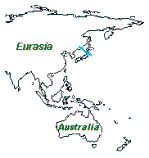
Geophysical Center of the Russian Academy of Sciences, Moscow, Russia
World Data Center for Solid Earth Physics
The Geotraverse Project
The Japan Sea Geotraverse

Format Description for the Earthquake Catalogue
Earthquake Catalogue has been composed from three parts:
1. (GUTE) Catalog of hypocenters and magnitudes listed in Gutenberg
and Richter (1954), 1904 - 1952.
Global Hypocenter Data Base CD-ROM, version 3.0, 1994, NEIC, USGS.
Gutenberg, B., and Richter, C.F., 1954, Seismicity of the
Earth and associated phenomena; Princeton University Press,
Princeton, NJ, 310 p.
2. (PDE) Preliminary Determination of Epicenters, NEIC, USGS,
1868-1992. Catalog of earthquakes located by the USGS NEIC and its
predecessors in the U.S. Coast and Geodetic Survey the National
Ocean Survey, and the Environmental Research Laboratories of the
Department of Commerce. Listings are in most cases the final
hypocenters and magnitudes of the USGS NEIC which are listed in
the Geological Survey publication, "Preliminary Determination of
Epicenters - Monthly Listing".
Global Hypocenter Data Base CD-ROM, version 3.0, 1994, NEIC, USGS.
3. (PDE, PDE-W, PDE-Q) USGS/NEIC, 1973-PRESENT:
Catalog of earthquakes located by the USGS NEIC and its
predecessors in the U.S. Coast and Geodetic Survey, the National
Oceanic Survey, and the Environmental Research Laboratories of the
Department of Commerce. Listings are from three different publications:
(PDE-W) PDE Weekly Listing. This file covers the time period following
the Monthly data up to four weeks behind the current week. The Weekly
PDE data are replaced by the Monthly PDE data as soon as they become
available.
USGS/NEIC Most Recent Events (PDE-Q) Daily listing, known as Quick
Epicenter Determinatins (QED). These data are extremely preliminary
and the parameters of the earthquakes are subject to change as more
data are used to relocate the earthquakes. The daily PDE-W covers the
time fram following the Weekly PDE data up to the current date. These
data are replaced by the Weekly PDE data.
(PDE) Preliminary Determinations of Epicenters, Monthly Listing.
This list is the most complete computation of hypocenters and
magnitudes done by the USGS NEIC. It is normally produced a few
months after the events occur. The publication is called "Preliminary"
because the "final" computation of hypocenters for the world is
considered to be the Bulletin of the Internation Seismological Centre
(ISC), which is produced about two years after the earthquakes occur.
The NEIC PDE program contributes about one-third off all data used by
the ISC.
http://wwwneic.cr.usgs.gov/neis/epic/epic.html
POSITIONS LENGTH FORMAT DESCRIPTION
OF FIELD
1- 5 5 (a5) Catalog Source
6-11 5 (a6) Year
12-13 2 (i2) Month
14-15 2 (i2) Day
16-24 9 (f9.2) Origin Time
17-18 2 (i2) Minute
25-26 2 (a2) Coordinate/OT Authority
27-33 7 (f7.3) Latitude in degrees [- =South]
34-41 8 (f8.3) Longitude in degrees [- =West]
42-46 5 (f5.1) Depth in kilometers
47 1 (a1) Depth Control Designator
48-49 2 (a2) pP Phases
50-53 4 (f4.2) Standard Deviation
54-56 3 (f3.1) mb magnitude
57-58 2 (i2) Number of mb amplitudes
59-61 3 (f3.1) Ms magnitude
62 1 (a1) Z/H Component
63-64 2 (i2) Number of Ms amplitudes
65-68 2 (f4.2) Contributed Mag1.
69-70 2 (a2) Magnitude Scale
71-75 5 (a5) Donor
76-79 4 (f4.2) Contributed Mag2.
80-81 2 (a2) Magnitude Scale
82-86 5 (a5) Donor
87-89 3 (i3) Flinn-Engdahl Region Number
90-92 3 (a3) Station Number/Quality
93 1 (a1) Intensity Value
94 1 (a1) Cultural Effects
95 1 (a1) Isoseismal Map
96 1 (a1) Fault Plane Solution flag
97 1 (a1) Moment Tensor Flag
98 1 (a1) ISC Depth Flag
99 1 (a1) IDE flag
100 1 (a1) Preferred Hypocenter flag
101 1 (a1) Flag
102-108 7 (a7) Phenomena Codes
109-115 8 (a7) Radial Distance
Seismological Data Sets | Data Sets | Main Page
2001-2016 © WDC for SEP, GC RAS webmaster